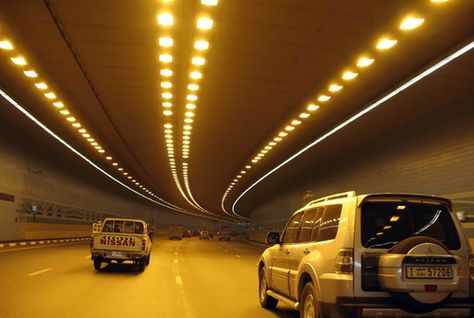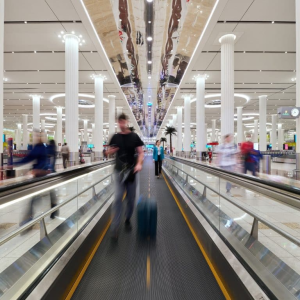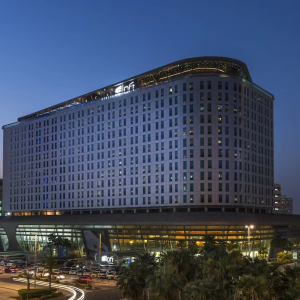Dubai, a city renowned for its architectural marvels and infrastructural advancements, is home to one of its most significant engineering feats—the Shindagha Tunnel. Connecting Deira and Bur Dubai, this tunnel has been an essential lifeline for daily commuters and a vital link in Dubai’s evolving transportation network. As Dubai continues its rapid expansion, the Shindagha Tunnel remains a critical component in the city’s ambitious infrastructure plans, adapting to the growing demands of residents, businesses, and tourists alike.
A Historical Landmark
The Shindagha Tunnel, officially known as the Al Shindagha Tunnel, was inaugurated in 1975 by the late Sheikh Rashid bin Saeed Al Maktoum. It was the first underwater tunnel in the Gulf region, a remarkable engineering achievement at the time. Built to facilitate seamless connectivity across Dubai Creek, the tunnel was a revolutionary project that marked Dubai’s transition into a modern metropolis. At the time of its completion, it was one of the most significant infrastructure projects in the region, highlighting Dubai’s commitment to innovation and urban development.
For decades, the tunnel has played a critical role in managing traffic flow, easing congestion, and enabling smooth connectivity between Deira and Bur Dubai. Before its construction, ferries and small bridges were the only means of crossing the Creek, often leading to travel delays and inefficiencies. The tunnel, with its state-of-the-art engineering and strategic location, changed the city’s transportation landscape forever.

Strategic Importance
The tunnel is a key component of Dubai’s road network, facilitating the movement of thousands of vehicles daily. It serves as a vital link for businesses, residents, and tourists navigating between the historic district of Bur Dubai and the commercial hub of Deira. As Dubai’s economy grew, so did the volume of traffic, making the tunnel an indispensable part of the city’s infrastructure.
Dubai’s rapid urban expansion and increasing population have led to an exponential rise in vehicles on the road. The Shindagha Tunnel has remained crucial in maintaining smooth traffic flow, particularly during peak hours when congestion can be a challenge. Its role in connecting key commercial areas ensures that trade, tourism, and local businesses continue to thrive without major disruptions.

Additionally, the tunnel supports Dubai’s logistical and trade operations, allowing for the efficient movement of goods and services between key economic zones. As a major transit point for goods being transported across the city, the tunnel’s efficiency directly impacts Dubai’s economic growth and competitiveness on the global stage.
Recent Upgrades and Expansions
Recognizing the need to enhance the tunnel’s efficiency, the Roads and Transport Authority (RTA) of Dubai has implemented several upgrades and expansion projects over the years:
- Structural Maintenance: Periodic refurbishments have been conducted to reinforce the tunnel’s integrity and improve safety standards. With over four decades of operation, maintaining the tunnel’s infrastructure is a priority to ensure its long-term functionality.
- Traffic Management Systems: Advanced monitoring and control systems have been installed to optimize traffic flow and minimize congestion. These systems include real-time sensors, AI-driven analytics, and predictive traffic models that help streamline vehicle movement.
- Integration with Al Shindagha Corridor Project: The tunnel is part of the broader Al Shindagha Corridor project, a multibillion-dirham initiative aimed at transforming the entire road network around the Dubai Creek area. This includes the construction of new bridges, intersections, and alternative routes to accommodate the increasing number of vehicles. The project aims to provide more seamless connectivity, reducing reliance on the tunnel while improving overall traffic efficiency in the region.
Challenges and Solutions
Over the years, the tunnel has faced challenges due to increased traffic volume and urban expansion. Traffic congestion during peak hours, periodic maintenance requirements, and the need for alternative crossings have been some of the primary concerns.
To address these issues, Dubai’s RTA has implemented several measures:
- Traffic Diversion Strategies: Alternative crossings, including the Al Maktoum Bridge and the Floating Bridge, have been optimized to distribute traffic load more effectively.
- Public Transport Integration: Encouraging the use of public transport, including metro expansions, buses, and marine transport, has helped reduce dependency on private vehicles passing through the tunnel.
- Future Expansion Plans: Additional tunnels, bridges, and road networks are being developed to accommodate the growing population and traffic demands.
Future Developments
To cater to the growing demands of the city, Dubai’s authorities have planned several enhancements:
- Expansion of Road Networks: Additional tunnels and bridges are being developed to ease traffic pressure on the Shindagha Tunnel. These projects include expansions to nearby roadways, new tunnel projects, and alternative creek crossings.
- Smart Traffic Solutions: AI-driven traffic monitoring systems and predictive analytics are expected to further improve tunnel operations. These technologies will help optimize traffic flow, reduce bottlenecks, and enhance road safety.
- Alternative Transportation Modes: The tunnel’s future developments align with Dubai’s vision of integrating public transport, including metro expansions and marine transport options, to reduce dependency on road traffic. By encouraging sustainable mobility solutions, Dubai aims to create a more efficient and environmentally friendly transportation system.
Impact on Dubai’s Growth
The Shindagha Tunnel has significantly contributed to Dubai’s economic and infrastructural growth by:
- Enhancing Connectivity: Providing a seamless link between Deira and Bur Dubai, facilitating easy access for businesses and residents.
- Supporting Tourism: Allowing efficient access to heritage sites, modern attractions, and commercial centers, strengthening Dubai’s tourism appeal.
- Boosting Trade and Commerce: Enabling efficient movement of goods and services, supporting Dubai’s position as a global trade hub.
- Reducing Travel Times: Improving the overall urban mobility experience by minimizing congestion and streamlining traffic flow.
Cultural and Economic Significance
Beyond its functional importance, the Shindagha Tunnel holds cultural and historical significance as one of the city’s first major infrastructure projects. It represents Dubai’s early vision for modernization and urban development, serving as a foundation for the city’s subsequent transformation into a global metropolis. The tunnel has witnessed Dubai’s evolution from a modest trading hub to a world-class city with cutting-edge infrastructure.
The economic benefits of the tunnel are undeniable. By ensuring smooth transportation across Dubai Creek, it has facilitated trade, supported businesses, and contributed to the city’s economic vitality. As Dubai continues to position itself as a leader in smart mobility and sustainable urban development, the Shindagha Tunnel remains an integral part of the city’s long-term growth strategy.
Conclusion
As one of Dubai’s most historic and vital transportation links, the Shindagha Tunnel stands as a testament to the city’s continuous commitment to innovation and development. With ongoing expansions and modernization projects, it will remain an integral part of Dubai’s journey toward becoming a global smart city. From its origins as a pioneering underwater tunnel to its future as a key component of Dubai’s advanced transportation ecosystem, the Shindagha Tunnel is an enduring symbol of the city’s ambitious vision and relentless progress.
Do follow Uae stories for more Updates
UAE’s Development Road Project: A Strategic Alternative to the Suez Canal














